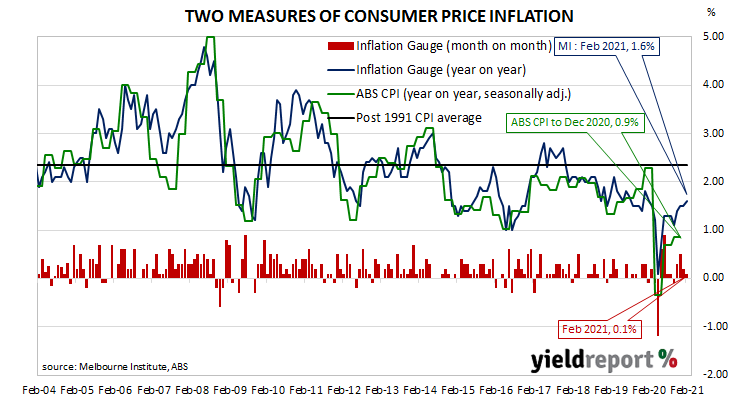Summary: Melbourne Institute inflation creeps up in February; annual rate ticks up.
Despite the RBA’s desire for a higher inflation rate, ostensibly to combat recessions, attempts to accelerate inflation through record-low interest rates have failed to date. The RBA’s stated objective is to achieve an inflation rate of between 2% and 3%, “on average, over time.” Since the GFC, Australia’s inflation rate has been trending lower and lower; the “coronavirus recession” then crushed it in the June quarter of 2020.

The Melbourne Institute’s latest reading of its Inflation Gauge index crept up by a modest 0.1% in February. The rise follows increases of 0.2% and 0.5% in January and December respectively. On an annual basis, the index rose by 1.6%, up from 1.5% in January.
The figures were released on the same day as a swag of local economic reports, including January’s housing finance figures and ANZ’s latest Job Ads survey. Commonwealth bond yields fell significantly on the day, reversing some of the previous week’s rises and following large falls of US Treasury yields on Friday night. By the close of business, the 3-year ACGB yield had shed 9bps to 0.28%, the 10-year yield had dropped 24bps to 1.67% and the 20-year yield finished 21bps to 2.36%.
The Melbourne Institute’s Inflation Gauge is an attempt to replicate the ABS consumer price index (CPI) on a monthly basis. It has turned out to be a reliable leading indicator of the CPI, although there are periods in which the Inflation Gauge and the CPI have diverged for as long as twelve months. On average, the Inflation Gauge’s annual rate tends to overestimate the ABS headline rate by around 0.1% on average.
Central bankers desire a certain level of inflation which is “sufficiently low that it does not materially distort economic decisions in the community” but high enough so it does not constrain “a central bank’s ability to combat recessions.” Hence the recent obsession among central banks, including the RBA, to increase inflation.

